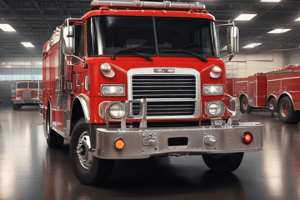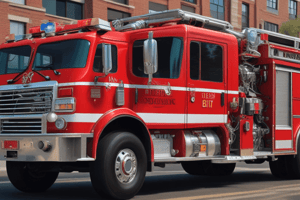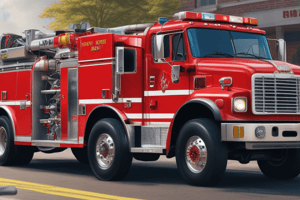Podcast
Questions and Answers
What is the main function of the truck company at a structure fire?
What is the main function of the truck company at a structure fire?
The main function of the truck company is to support the fire attack and provide the incident commander with peace of mind and a greater awareness of the situation.
The Fort Worth Fire Department has adopted the “Quint Concept.”
The Fort Worth Fire Department has adopted the “Quint Concept.”
True (A)
What is short-jacking?
What is short-jacking?
Short-jacking is a tactic which extends the outriggers on the building or working side of the truck and drops the outriggers on the non-working side without extension.
What is the main factor in deciding apparatus placement?
What is the main factor in deciding apparatus placement?
Which of the following are the primary functions of the Inside Team?
Which of the following are the primary functions of the Inside Team?
What is the main objective of the Truck Company at a structure fire?
What is the main objective of the Truck Company at a structure fire?
Which tasks should be completed in the first 5-10 minutes of the incident?
Which tasks should be completed in the first 5-10 minutes of the incident?
The second truck should always spot on the opposite side of the structure as the first truck.
The second truck should always spot on the opposite side of the structure as the first truck.
What is the purpose of Gap-Set-Force?
What is the purpose of Gap-Set-Force?
Which of the following entry methods is most appropriate for inward-swinging doors?
Which of the following entry methods is most appropriate for inward-swinging doors?
What is the primary consideration for Forcible Entry?
What is the primary consideration for Forcible Entry?
Describe the roles of the Inside and Outside teams during Forcible Entry.
Describe the roles of the Inside and Outside teams during Forcible Entry.
What is the most frequent type of mayday?
What is the most frequent type of mayday?
The RIT team is located on the inside with the initial attack team.
The RIT team is located on the inside with the initial attack team.
What is the primary focus of an Active RIT team?
What is the primary focus of an Active RIT team?
The goal of the Truck Company is to ensure the fire is out.
The goal of the Truck Company is to ensure the fire is out.
What is the primary means of ventilation?
What is the primary means of ventilation?
Which type of ventilation is most commonly used to support the attack?
Which type of ventilation is most commonly used to support the attack?
Vertical ventilation serves as a means to limit lateral extension of the fire.
Vertical ventilation serves as a means to limit lateral extension of the fire.
What is the minimum size of a vent hole?
What is the minimum size of a vent hole?
What is the sounder's role?
What is the sounder's role?
The roof team leader should keep command updated on the progress of the vent hole in addition to their location.
The roof team leader should keep command updated on the progress of the vent hole in addition to their location.
What is the “Rule of Thumb” for the second truck at apartment and commercial fires?
What is the “Rule of Thumb” for the second truck at apartment and commercial fires?
The primary purpose of a Trench Cut is to improve visibility.
The primary purpose of a Trench Cut is to improve visibility.
Which of the following is NOT a valid reason to forego Vertical Ventilation?
Which of the following is NOT a valid reason to forego Vertical Ventilation?
The Truck Company is always responsible for the overhaul of the fire.
The Truck Company is always responsible for the overhaul of the fire.
What is the general rule of thumb for determining the appropriate size of a vent hole?
What is the general rule of thumb for determining the appropriate size of a vent hole?
The Truck Officer should always take command of the incident.
The Truck Officer should always take command of the incident.
When should the Truck Officer pass off command to an incoming officer?
When should the Truck Officer pass off command to an incoming officer?
The Truck Company should always be staffed with 4 personnel.
The Truck Company should always be staffed with 4 personnel.
What is the primary advantage of a Quint?
What is the primary advantage of a Quint?
The Quint concept provides all the functions necessary for any fire.
The Quint concept provides all the functions necessary for any fire.
The Truck Officer should make sure that command is taken immediately.
The Truck Officer should make sure that command is taken immediately.
The most significant tactical challenges in High-Rise buildings are the lack of access to upper floors, difficulty evacuating occupants, and properly ventilating.
The most significant tactical challenges in High-Rise buildings are the lack of access to upper floors, difficulty evacuating occupants, and properly ventilating.
What is important to consider when sizing up the building?
What is important to consider when sizing up the building?
The Truck Officer should always park on the building side of the street when responding to a High-Rise.
The Truck Officer should always park on the building side of the street when responding to a High-Rise.
The Lobby Officer should remain stationary in the lobby.
The Lobby Officer should remain stationary in the lobby.
The Fire Control Room Firefighter is responsible for maintaining the building alarm panel.
The Fire Control Room Firefighter is responsible for maintaining the building alarm panel.
What is the Building Systems Firefighter’s main duty?
What is the Building Systems Firefighter’s main duty?
The Elevator Operator is responsible for evacuating occupants from the elevator shaft.
The Elevator Operator is responsible for evacuating occupants from the elevator shaft.
A major component of High-Rise operations is proper ventilation.
A major component of High-Rise operations is proper ventilation.
The first arriving Truck Company is responsible for handling lobby functions.
The first arriving Truck Company is responsible for handling lobby functions.
What are two components of the initial size up of a High-Rise building?
What are two components of the initial size up of a High-Rise building?
The first arriving Truck Company is responsible for handling the primary search.
The first arriving Truck Company is responsible for handling the primary search.
The Engine Officer should maintain control of the fire door until the Engine Company is ready with a charged hoseline.
The Engine Officer should maintain control of the fire door until the Engine Company is ready with a charged hoseline.
The Division Supervisor remains in Command Mode during the search.
The Division Supervisor remains in Command Mode during the search.
The Stairwell Stretch is only used when smoke or fire conditions are present.
The Stairwell Stretch is only used when smoke or fire conditions are present.
Flashcards
Apparatus Positioning
Apparatus Positioning
The strategic placement of fire trucks at an incident scene to optimize effectiveness.
Short-Jacking
Short-Jacking
A tactic used to save space by only extending outriggers on one side of the truck.
Scrub Area
Scrub Area
The area reachable by the ladder, allowing access to windows and roofs.
Collapse Zones
Collapse Zones
Signup and view all the flashcards
Forcible Entry
Forcible Entry
Signup and view all the flashcards
Gap-Set-Force
Gap-Set-Force
Signup and view all the flashcards
Primary Search
Primary Search
Signup and view all the flashcards
Secondary Search
Secondary Search
Signup and view all the flashcards
VEIS
VEIS
Signup and view all the flashcards
Reconnaissance
Reconnaissance
Signup and view all the flashcards
Elevated Master Streams
Elevated Master Streams
Signup and view all the flashcards
Utility Control
Utility Control
Signup and view all the flashcards
Search & Rescue
Search & Rescue
Signup and view all the flashcards
Company Unity
Company Unity
Signup and view all the flashcards
Coordination in Ventilation
Coordination in Ventilation
Signup and view all the flashcards
Victim Reports
Victim Reports
Signup and view all the flashcards
Fire Attack Support
Fire Attack Support
Signup and view all the flashcards
Communication in Emergencies
Communication in Emergencies
Signup and view all the flashcards
Flow Path Control
Flow Path Control
Signup and view all the flashcards
Laddering Techniques
Laddering Techniques
Signup and view all the flashcards
Vertical Ventilation
Vertical Ventilation
Signup and view all the flashcards
Positive Pressure Ventilation
Positive Pressure Ventilation
Signup and view all the flashcards
Utility Risks
Utility Risks
Signup and view all the flashcards
Master Stream Operations
Master Stream Operations
Signup and view all the flashcards
Passive Entry Tactics
Passive Entry Tactics
Signup and view all the flashcards
Crew Empowerment
Crew Empowerment
Signup and view all the flashcards
Incident Command Coordination
Incident Command Coordination
Signup and view all the flashcards
Rapid Intervention Teams (RIT)
Rapid Intervention Teams (RIT)
Signup and view all the flashcards
Understanding Apparatus Limitations
Understanding Apparatus Limitations
Signup and view all the flashcards
Incident Analysis
Incident Analysis
Signup and view all the flashcards
Riding Assignments
Riding Assignments
Signup and view all the flashcards
Study Notes
Fort Worth Fire Department Truck Company Operations Manual
- This document details standardized procedures for truck company duties at structure fires.
- Its purpose is to provide consistent methods, ensure all support functions are performed timely, and standardize truck company operations at a fire scene.
- The manual aims to provide a practical, applicable expectation of truck work.
- Previous methods varied by location of assignments, officer experience, and perceived risk taken by incident commanders.
Apparatus Positioning
- Prioritize positioning, focusing on "Position, Don't Park" to allow for maneuverability.
- Aerial device positioning is critical, considering capabilities (e.g., length, outriggers, and safety overrides) and constraints (e.g., narrow roadways, parked cars, overhead obstructions).
- Short-Jacking is a technique to maximize space use in confined areas, such as narrow alleys.
Position for Multi-Use
- Apparatus placement is primarily dictated by the intended task (e.g., upper-floor rescue).
- A sufficient "scrub area" is essential for multiple side building window access.
- Positioning should account for potential collapse zones, which are generally 1.5-2 times the building height.
Rear-Mount Apparatus
- Rear mount apparatuses offer versatility, particularly useful for narrow roadways or alleyways.
- The ladder's location atop the truck minimizes interference. The primary disadvantage is reduced length when extending over the front of the truck in tight spaces.
Mid-Mount Apparatus
- Mid-mount apparatuses come with advantages for spotting the turntable under overhead obstructions and performing roof, overhaul or defensive fire operations.
- Versatility in location allows for quicker, efficient and safer positioning relative to the target.
- Disadvantages include the potential for mounted accessories to impede efficient maneuverability in certain situations.
Where to Position
- Prioritize placing the ladder truck in front of a building to maximize accessibility to at least two sides and the roof.
- Account for potential constraints like setbacks, existing apparatus, overhead obstructions, and collapse zones.
First Truck Positioning Goals
- Identify the most tactically valuable position based on the incident location, type of emergency, occupancy type, and location of other apparatus.
- Frequently, first-due trucks are positioned next to the first arriving engine company on the side targeted for initial entry.
Second Truck Positioning Goals
- The positioning of the second arriving truck should be opposite the first, to fulfill roles not covered by the first truck.
- In commercial/multi-story contexts opposite positioning is critical to allow for effective coverage of multiple building sides.
Riding Assignments
- Standard riding assignments for Truck 24 on the C-shift are given.
- Roles include those of the Engineer, Left Firefighter, and Right Firefighter.
- The appropriate tools and equipment should be staged.
The 10 Functions of the Truck Company
- The 10 functions are presented including a prioritization hierarchy.
- These functions are typically conducted within the first 5-10 minutes of arrival at the scene.
- Each function should be coordinated and performed concurrently when circumstances permit.
Forcible Entry
- Forcible entry should be considered immediately on arrival.
- Initial priority is forcing ingress and egress.
- Passive entry techniques (e.g., using tools, removal of locks) are frequently used when damage to the door frame should be avoided or emergency response is less urgent.
- Commercial and residential structures have variations in construction and tools required.
Gap-Set-Force
- Forcible entry in residential structures often involves a "gap-set-force" method using an adz
- This approach is characterized using tools like Halligan bars for leveraging or the K-tool for turning or removing locks.
Search and Rescue
- Search and rescue is a paramount aspect of truck company duties, beginning at the time of arrival.
- Ensuring that every space (room, closet and crawl spaces) is checked thoroughly.
Profiling
- Profiling buildings based on the initial assessment will inform the search procedures and tactics.
Compartmentalized Searches
- Involves compartmentalized structures, the advantages of this type of structure include the ability to maintain orientation and seek refuge in rooms from fire growth, greater offerings of exit points. This includes 1 and 2 family residences, and apartments.
Non-Compartmentalized Searches
- Emphasizes the use of tools like the TIC to optimize search within these structures, such as restaurants, warehouses, and similar open structures.
Encountering a Victim
- Responsibility of team leader is to alert command to ensure a speedy response, as well as gather information.
Vertical Ventilation
- Vertical ventilation involves removing smoke and heat from a fire by cutting a vent hole in the roof.
- The goal is to stabilize conditions for effective fire attack and evacuation.
Positive Pressure Ventilation
- Positive pressure ventilation (PPV) involves pressurizing a structure to push fire and smoke away from occupants and firefighters.
- This tactic is typically performed after a fire has been controlled.
Reconnaissance
- Comprehensive assessments of the area (exterior, interior, and access) for identifying fire conditions, building layout, and accessibility constraints. The 360 process is a crucial part of this approach.
Elevated Master Streams
- Elevated master streams are a method for providing water to high-rise buildings.
- This method should often be considered a secondary option. It makes the Fire Officer's job more complex, requires the active engagement of the Engine Company, and often depends on whether or not there are available water inlets throughout the building.
Utility Control
- Includes responsibility for shutting off electrical, gas, and water services to confine the fire.
- Priority is given to electrical, natural gas, and water supplies as they could aid in the spread of the fire if not managed proactively.
Specific Notes
- Many of the tasks and procedures are dependent upon the type of building, layout, occupants, and the presence of potentially significant impediments.
- Every approach is affected by the need for communication.
Studying That Suits You
Use AI to generate personalized quizzes and flashcards to suit your learning preferences.




